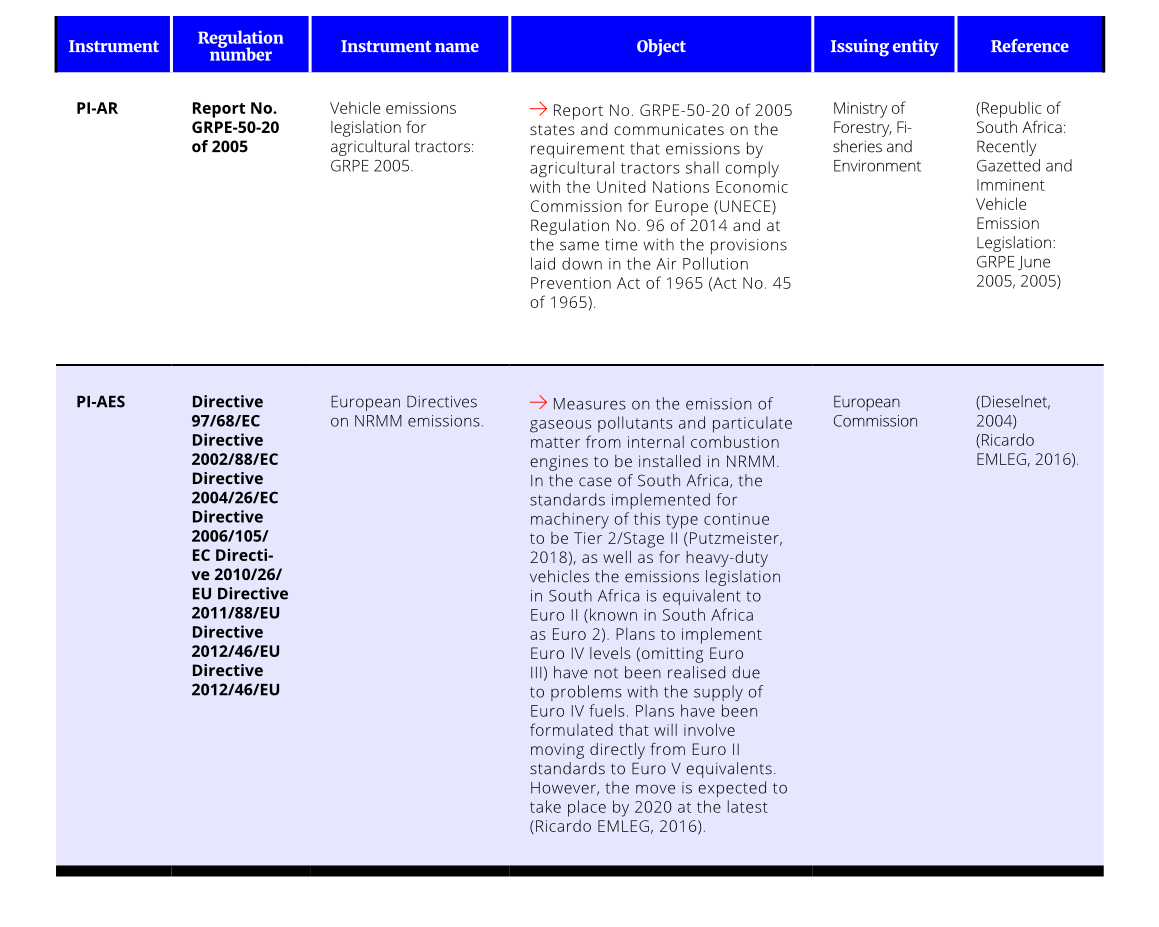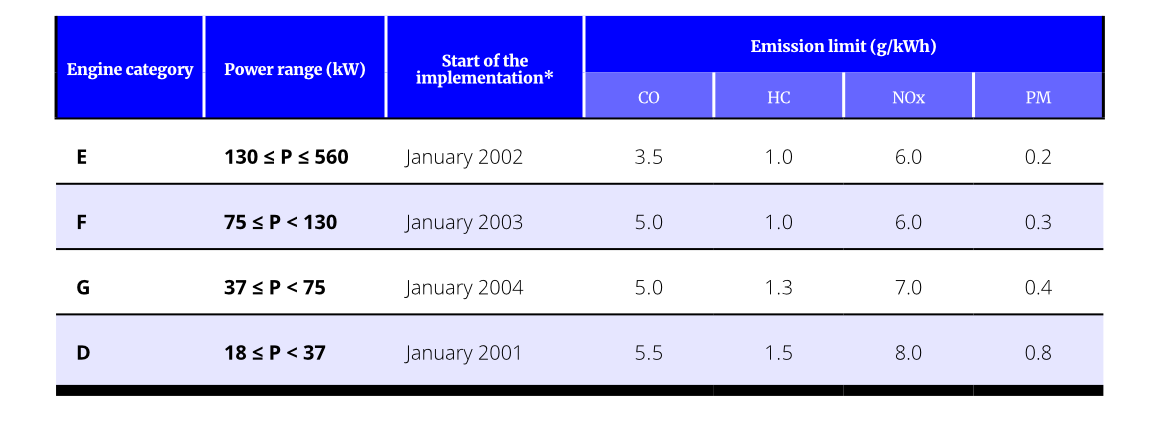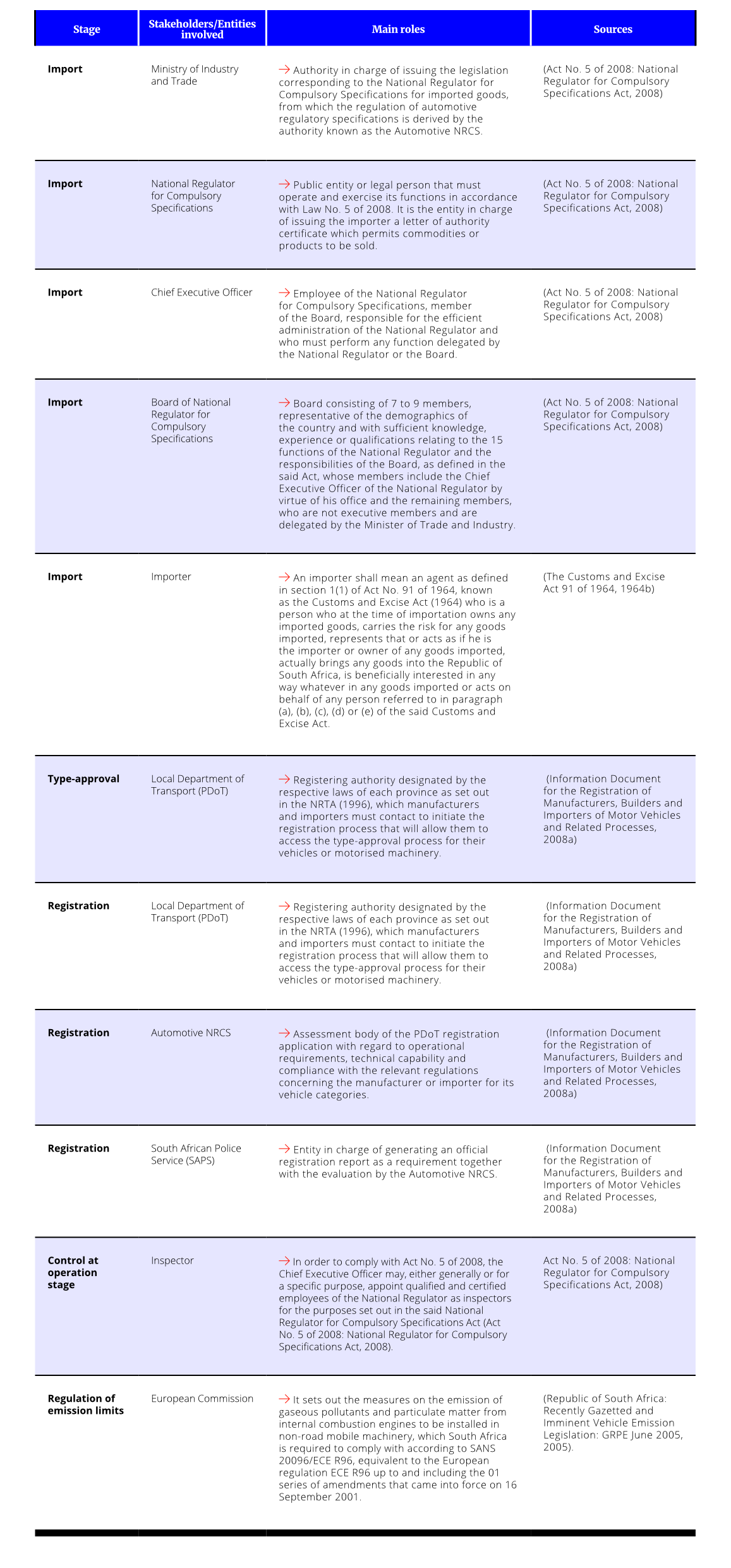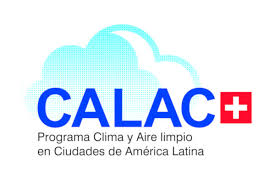SOUTH AFRICA

/1/
Definitions of
non-road mobile
machinery
According to Report No. GRPE-50-20 of 2005 on Vehicle Emission Legislation for Agricultural Tractors, published in the Gazette of the Republic of South Africa, paragraph 4.2, the exhaust emission from the engine of an agricultural tractor shall be such that it complies with the applicable regulations in force promulgated under the Atmospheric Pollution Prevention Act of 1965 (Act 45 of 1965). In addition, the exhaust emissions from the engine of an agricultural tractor shall comply with SANS 20096/ECE R96: Uniform provisions concerning the approval of compression-ignition (C.I.) engines to be installed in agricultural and forestry tractors and in non-road mobile machinery with regard to the emissions of pollutants by the engine, […] The exhaust emission from the engine of an agricultural tractor shall be such as to comply with the applicable regulations promulgated under the Air Pollution Prevention Act, 1965 (Act 45 of 1965). equivalent to ECE Regulation R96 up to and including the 01 series of amendments which entered into force on 16 September 2001 (Republic of South Africa: Recently Gazetted and Imminent Vehicle Emission Legislation: GRPE June 2005, 2005).
According to the above and as stated in the aforementioned SANS 20096/ECE R96 document known as United Nations Economic Commission for Europe (UN/ECE) Regulation No. 96, effective since 2001, the emission standard for non-road mobile machinery will have a scope for the emission of gaseous and particulate pollutants from compression ignition (CI) engines in the following cases:
- Used in T-category vehicles with a net installed power greater than 18 kW but less than 560 kW;
- Used in non-road mobile machinery with a net installed power greater than 18 kW but less than 560 kW, operating at variable speed; and
- Used in non-road mobile machinery with a net installed power greater than 18 kW but less than 560 kW, operating at constant speed.
In order to understand these regulations, reference is made in the aforementioned standard to the definitions presented by the Consolidated Resolution on the Construction of Vehicles (R.E.3) ECE/ TRANS/WP.29/78/Rev.2 (2017) in paragraph 2
- Non-road mobile machinery: Any mobile machine, portable industrial equipment or vehicle with or without body work, not intended for the use of passenger- or goods-transport on the road, in which an internal combustion engine is installed;
- Categories T, R and S: agricultural vehicles;
- Category T: A power-driven vehicle, either wheeled or forestry vehicle, which has at least two-axles and a maximum design speed of not less than 6 km/h, whose function depends essentially on its tractive power, and which is specially designed to pull, push, carry or power certain implements, machines or trailers designed to perform agricultural or forestry work, or to tow agricultural or forestry equipment. Such a tractor may be arranged to carry a load and attendants.
- Category-R – Agricultural trailer: any agricultural or forestry vehicle intended mainly to be towed by a tractor and intended primarily to carry loads or process materials and where the ratio of the technically permissible maximum laden mass to the unladen mass of that vehicle is equal to or greater than 3.0; and
- Category-S – Interchangeable towed equipment: means any vehicle used in agriculture or forestry which is designed to be towed by a tractor, changes or adds to its functions, permanently incorporates an implement or is designed to process materials, which may include a load platform designed and constructed to receive all tools and appliances needed for those purposes and to store temporarily any materials produced or needed during work and where the ratio of the technically permissible maximum laden mass to the unladen mass of that vehicle is less than 3.0.

/2/
Main regulatory
instruments for NRMM
emissions reduction
A compilation of different types of instruments identified in South Africa for the control of air pollution generated by NRMM is presented in Table 1.
TABLE 1
Regulatory framework and identification of NRMM emission reduction tools – South Africa.

Source: self made.

/3/
Emission standards
for air pollutants
The following table presents the emission standards for local pollutants, with their date of adoption.
TABLE 2
EU Stage II emission standards for diesel engines in non-road motor vehicles.

* Stage II also applies to constant speed motors since January 2007.
Source: (Dieselnet, 2004).

/4/
Import requirements
and type-approval
processes
4.1 Requisitos de importación y homologación
According to SAAMA (2008), any manufacturer, importer or builder (MIBs) who manufactures, builds, imports or modifies motor vehicles for the purpose of his or her business of selling motor vehicles or modifications of motor vehicles shall register by following the steps below.
- Application for registration
- Contact the local Department of Transport (PDoT), the following will be required:
- Complete application and notice form in respect of manufacturer, importer and builder of motor vehicles (MIB) form which can be found at https://www.gauteng.gov.za/Services/GetServices?serviceId=CPM-001666. (Gauteng Provincial Government, 2021), as well as contact information of the PDoT officer per province in the ‘Information Document for the Registration of Manufacturers, Builders and Importers of Motor Vehicles and Related Processes’ of the Automotive NRCS. (NRCS, 2020).
- Certified copy of applicant’s identity document (ID).
- Certified copy of the proxy´s identification (if the applicant is a body of persons).
- Certified copy of the business certificate (if the applicant is a body of persons).
- Letter of proxy if you represent a company.
- Custom code number from SARS (South African Revenue Service), in the case of application for registration of importer.
- Proof of VAT registration from SARS.
- The appropriate fees as determined by the Member of the Executive Council (MEC) of the province concerned, and.
- Any other requirements by the PDoT.
- Contact the local Department of Transport (PDoT), the following will be required:
- Request for evaluation of the applicant
On receipt of an application the PDoT will ensure the application is in order, require the NRCS Automotive to evaluate the application and make a recommendation and require the South African Police Service (SAPS) to submit a report.
- Evaluation of the applicant by NRCS Automotive
The NRCS Automotive will contact the applicant to verify all details as per the application form and to inform the applicant about the evaluation requirements. The process covers the evaluation of:
- Management system.
- Technical competency of personnel involved.
- Understanding of the relevant legislation, specification and code of practice in relation to the type and category of vehicle involved, and
- Compliance of products with the relevant legislation.
- Registration certificate
if the PDoT is satisfied that the applicant is suitable to be registered based on the evaluation of the NRCS automotive and the saps, it registers the applicant, record the particulars on the register of MIB’s and issue the applicant with a certificate. The registration certificate gives permission to:
- Apply for the world manufacturer identifier code (WMI) for use in compiling a vehicle identification number (VIN) – manufacturers only.
- Apply for the homologation/approval of the motor vehicle models.
- Importers to apply for LOA3/exemption in terms of NRTA for approval samples.
- Apply for model numbers on notification of vehicle model form (NVM form), and
- Register vehicles on the national traffic information system (NaTIS).
[…] all import and export trade transactions related to agricultural machinery and commodities in this sector require that the products in the customs declarations are classified according to an appropriate tariff heading.
Additionally, for processes between South Africa and the United States, according to the US International Trade Administration, all import and export trade transactions related to agricultural machinery and commodities in this sector require that the products in the customs declarations are classified according to an appropriate tariff heading. The tariff classification code is directly related to the rate of duty payable on that product and can be found in Act No. 91 of 1964 for all agricultural and construction machinery. The classification operates as part of the International Harmonised Commodity Coding System under the Harmonised System Convention of the World Customs Organisation (WCO). The import of all second-hand goods is subject to import control and an import permit issued by the International Trade Administration Commission (ITAC) is required (South African Government, 2021b; The Customs and Excise Act 91 of 1964, 1964a; US International Trade Administration, 2020).

/5/
Labelling
processes
No information for South Africa

/6/
Regulation on machinery
useful life, repowering, overhaul and
scrapping practices
In order to deregister a motor vehicle, the ADV form provided by the registration authority through the eNATIS portal of the National Traffic Information System must be completed. The vehicle in question must comply with the South African Government’s requirements for this process (2021a) (although it is not explicitly stated that they apply to off-road machinery):
- has been declared permanently unfit to be on a public road;
- has been stolen;
- has been permanently demolished;
- becomes exempt from registration.
The registering authority will then issue a deregistration certificate. A motor vehicle that has not been licensed for four years shall be deregistered automatically.
The application instructions are to go to the nearest registering authority and submit the following:
- a certified copy of the identity document;
- a certified copy of the proof of ownership of the motor vehicle;
- supporting documentation if required;
- the vehicle´s registration certificate; and
- complete the application for deregistration of vehicle (ADV) form.
In this case the legislation does not specify whether its application is general, and whether it covers NRMM or not.

/7/
Operational and road
circulation requirements
No information for South Africa

/8/
Procedures for NRMM
control and inspection
in the operation stage
No information for South Africa

/9/
Actors in import processes, manufacturing, registration, marketing, control and final practices of useful life of the MMNC
The table below presents the main stakeholders involved in NRMM processes in South Africa. Further details of these processes are presented below.
TABLE 12 – 10
Stakeholders and roles – South Africa

Fuente: elaboración propia.
The South African Agricultural Machinery Association (SAAMA) states in its information document for the registration of manufacturers, builders and importers of motor vehicles and related processes (2008) that the National Regulator for Compulsory Specifications (Automotive NRCS) is mandated to enforce compliance of the automotive products with the relevant national legislation. The mandate is derived from two acts of parliament being:
- Act No. 5 of 2008, known as the National Regulation for Compulsory Specifications (NRCS).
- Act No. 93 of 1996, known as the National Road Traffic Act (NRTA).
The Automotive NRCS then covers several mandatory specifications for all products in this class, as well as mandatory inspection of manufacturers, importers and builders (MIBs) of motor vehicles.
The NRCS (2008), in its first section, establishes the following definitions related to the process of importation, manufacture, registration, sale and operation.
Import
Minister: the minister responsible for trade and industry.
National Regulator: National Regulator for Compulsory Specifications of South Africa, established as a public entity or legal person that must operate and exercise its functions in accordance with Law No. 5 of 2008. It is the entity in charge of issuing the importer a letter of authority certificate which allows commodities or products to be sold.
Chief Executive Officer: employee of the National Regulator for Compulsory Specifications, member of the Board, responsible for the efficient administration of the National Regulator and who must perform any function delegated by the National Regulator or the Board.
Regulatory Board: Board of National Regulator for Compulsory Specifications, consisting of 7 to 9 members, representative of the demographics of the country and with sufficient knowledge, experience or qualifications relating to the 15 functions of the National Regulator and the responsibilities of the Board, as defined in the said Act, whose members include:
- The Chief Executive Officer of the National Regulator by virtue of his office.
- The remaining members, who are not executive members and are delegated by the Minister.
Importer: according to the NRCS, an importer shall mean an agent as defined in section 1(1) of Act No. 91 of 1964, known as the Customs and Excise Act (1964) who is a person who at the time of importation:
- Owns any imported goods.
- Carries the risk for any goods imported.
- Represents that or acts as if he is the importer or owner of any goods imported.
- Brings any goods into the Republic of South Africa.
- Is beneficially interested in any way whatever in any goods imported or acts on behalf of any person referred to in subparagraphs (a), (b), (c), (d) or (e).
Manufacturing and distribution
From the NRCS (2008), in its first section, the following stakeholders are identified:
Manufacturer: in terms of the NRTA, a person who, for the purpose of carrying on a business of selling motor vehicles, manufactures or assembles new vehicles. In general terms of the NRCS, it is a person who produces, assembles, alters, modifies, adapts, converts, processes or treats products or goods.
National Regulator: in terms of manufacturing, the National Regulator is in charge of issuing the importer a letter of authority certificate which permits commodities or products to be sold, as well as services to be provided.
Registration
According to SAAMA (2008), the following stakeholders will be involved in the registration process:
Local Department of Transport (PDoT): registering authority designated by the respective laws of each province as set out in the NRTA. (1996), which manufacturers and importers must contact to initiate the registration process that will allow them to access the type-approval process for their vehicles or motorised machinery.
Automotive NRCS: assesses the PDoT registration application with regard to operational requirements, technical capability and compliance with the relevant regulations concerning the manufacturer or importer for its vehicle categories.
South African Police Service (SAPS): entity in charge of generating an official registration report as a requirement together with the evaluation by the Automotive NRCS.
Sale
From the NRCS (2008), in its first section, the following stakeholders are defined in terms of sales activity:
Seller: A person who:
- Displays, offers or advertises for sale.
- Exports from the Republic of South Africa for or in pursuance of a sale.
- Has in its possession goods for the purpose of sale, trade, manufacture or export from the Republic.
- Exchanges, donates, rents or offers goods.
National Regulator: the National Regulator shall issue a permit for sale to the seller upon compliance with section 14(4) of the aforementioned Act.
Control and inspection
Automotive NRCS: according to the SAAMA (2008), the Automotive NRCS is the entity in charge of the inspection of vehicle manufacturers and importers.
Inspector: in order to ensure compliance with Act No. 5 of 2008, the Chief Executive Officer may, in general or for a specific purpose appoint suitably qualified employees of the National Regulator as inspectors for the purposes set out in the said National Regulator for Compulsory Specifications Act (National Regulator for Compulsory Specifications Act, 2008 (Act No. 5 of 2008), 2008).
End of life
Registering authority: Corresponding to the Local Department of Transport, it will be the local entity in charge of administering the process of deregistration of a motor vehicle depending on its jurisdiction and will be responsible for generating a certificate for this process when it meets the requirements specified by the South African Government, as well as when it has not been renewed for more than 4 years. Although it is not specified that the procedure is applicable for non-road mobile machinery, the requirements are currently stipulated generally for motor vehicles (South African Government, 2021a).
Documentos de consulta (descargables)
